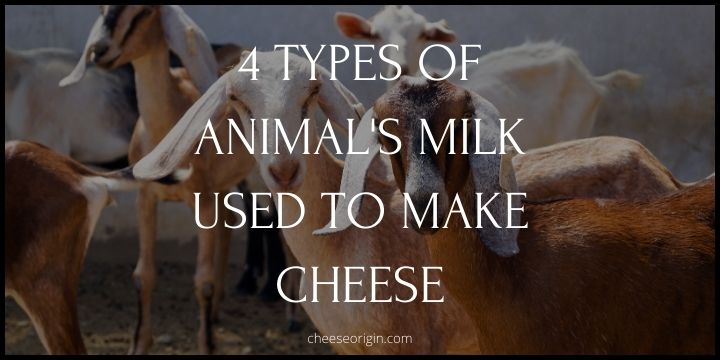4 Common Types of Animal’s Milk Used to Make Cheese

There are only some ruminants’ milk that can be made into cheese. Ruminants such as cows, goats, sheep (ewes), and water buffaloes are the most common milks that made some of the most delicious cheeses all around the world.
Milks that are produce by these ruminants contains the vital K-casein which coagulates due to rennet, a natural-causing enzyme (what is rennet?), found in their stomach lining.
Without K-casein, milk will stay liquid and cannot be made into cheese.
Recommended read: What is ‘Fake’ Synthetic Cheese Made Of?
The Most Common Milk Cheeses In Different Parts of the World
| Continent | Ruminant(s) |
|---|---|
| North America | Cow |
| South America | Cow |
| Europe | Goat and Sheep |
| West Asia | Goat and Sheep |
| East Asia | Water Buffalo |
| Africa | Cow |
| Australia/Oceania | Cow |
Did you know?
Cheese can also be made from the milk of camels, yaks, donkeys, moose, mares, and even humans (we are mammals after all) – nevertheless, it’s more challenging and difficult to make and it often comes with an outrageous premium price.
Also read: The Amount of Milk Required to Make Cheese
The 4 Most Common Types of Animal’s Milk to Make Cheese
| Cow’s Milk: | Cheese made with cow’s milk are usually neutral and mild. Textures are more toward the tense and firm side. |
| Goat’s Milk: | Goat’s milk has smaller fat globules and lactose that some people may find easier to digest. Cheese made with goat’s milk are usually stronger and sour in flavor. Textures tend to be tender and soft. |
| Sheep’s Milk: | Cheese made with sheep’s milk is mild and creamy with a hint of natural sweet taste (sometimes a little nutty). Due to its high percentage of butterfat content, some sheep’s milk cheeses will visibly sweat when left out for longer periods of time. |
| Buffalo’s Milk: | Cheese made with buffalo’s milk has a mild and pleasant sourness in its finish. The famous mozzarella di bufala is made from water buffalo’s milk which has a soft, moist and somewhat granular texture. |
One of the easiest way to categorize cheeses is by milk type. These are the 4 most common ones:
Cow’s Milk
The modern dairy cows can produce an average of 8 gallons of milk per day. It’s versatile and extremely abundant. Cow’s milk taste sweet, luscious and creamy.
This milk has fewer short-chain fatty acids compared to goat’s milk.
Interesting read: Goat Cheese vs. Cow Cheese (THE DIFFERENCES)
The Average Composition of Cow’s Milk
| Water | 87.0 % |
| Albuminous protein | 0.4 % |
| Casein | 3.3 % |
| Lactose | 4.8 % |
| Butterfat | 3.8 % |
| Minerals | 0.7 % |
| Total solids | 13.0 % |
Goat’s Milk
In addition to grasses, goats eat the leaves of many trees and shrubs. Consequently, wild herbs and plants in a region could influence the flavor of goat’s milk and cheese.
Goat’s milk is not as sweet as cow’s milk and contains more short-chain fatty acids giving it a distinct flavor that results in tangy, light fresh cheeses and earthy aged cheeses.
The Average Composition of Goat’s Milk
| Water | 86.0 % |
| Albuminous protein | 1.0 % |
| Casein | 3.3 % |
| Lactose | 4.4 % |
| Butterfat | 4.5 % |
| Minerals | 0.8 % |
| Total solids | 14.0 % |
Sheep’s Milk
Also known as ewes, sheep produce merely a tenth of the milk annually that cows do. However, sheep’s milk contains twice the fat and 70% more protein than cow’s milk.
Mongers only need half as much sheep’s milk to produce the same amount of cheese.
As a result, their rich buttery milk is highly sought-after for cheesemaking.
Signature sheep’s milk cheeses include Roquefort, Manchego, feta, and Pecorino.
Did you know?
Fresh sheep’s milk is nearly impossible to find at major retailers, but if you are lucky to have a sheep dairy in your locality, you may be able to buy fresh sheep’s milk straight from the farm.
The Average Composition of Sheep’s Milk
| Water | 81.1 % |
| Albuminous protein | 1.1 % |
| Casein | 4.6 % |
| Lactose | 4.7 % |
| Butterfat | 7.5 % |
| Minerals | 1.0 % |
| Total solids | 18.9 % |
Buffalo’s Milk
Though Italy is known for its iconic ultra-rich mozzarella di bufala, the vast majority of the world’s buffalo are raised across Asia.
Buffalo’s milk cheeses are sold in India, China, Indonesia, and the Philippines.
Did you know?
The buffalo is the second-highest milk producer in the world (representing 11% of global milk-production), second only to cow.
The Average Composition of Water Buffalo’s Milk
| Water | 82.7 % |
| Albuminous protein | 0.7 % |
| Casein | 3.8 % |
| Lactose | 4.5 % |
| Butterfat | 7.5 % |
| Minerals | 0.8 % |
| Total solids | 17.3 % |
Conclusion: The Quality of Animal’s Milk Varies
The truth is, cheese made with different milk from different livestock in different feeding conditions will give a different quality of cheese.
There are several determining factors to the quality of milk, especially the levels of proteins and butterfat.
Needless to say, farmers play a critical role in producing the world’s finest milk and cheese. We should really take time to appreciate hardworking farmers from all around the world every now and then.
Farmers know the natural cycles and the influence that seasons and climate can have on their livestock.
To put it simply: Two exact cheeses created with milk from two different breeds of cow will garner different flavors.
Did you know?
An animal’s lactation cycle affects the composition of milk. The milk in early lactation is less concentrated than in late lactation. This cycle also depends on what the animal eats.
Articles You Might Be Interested:





